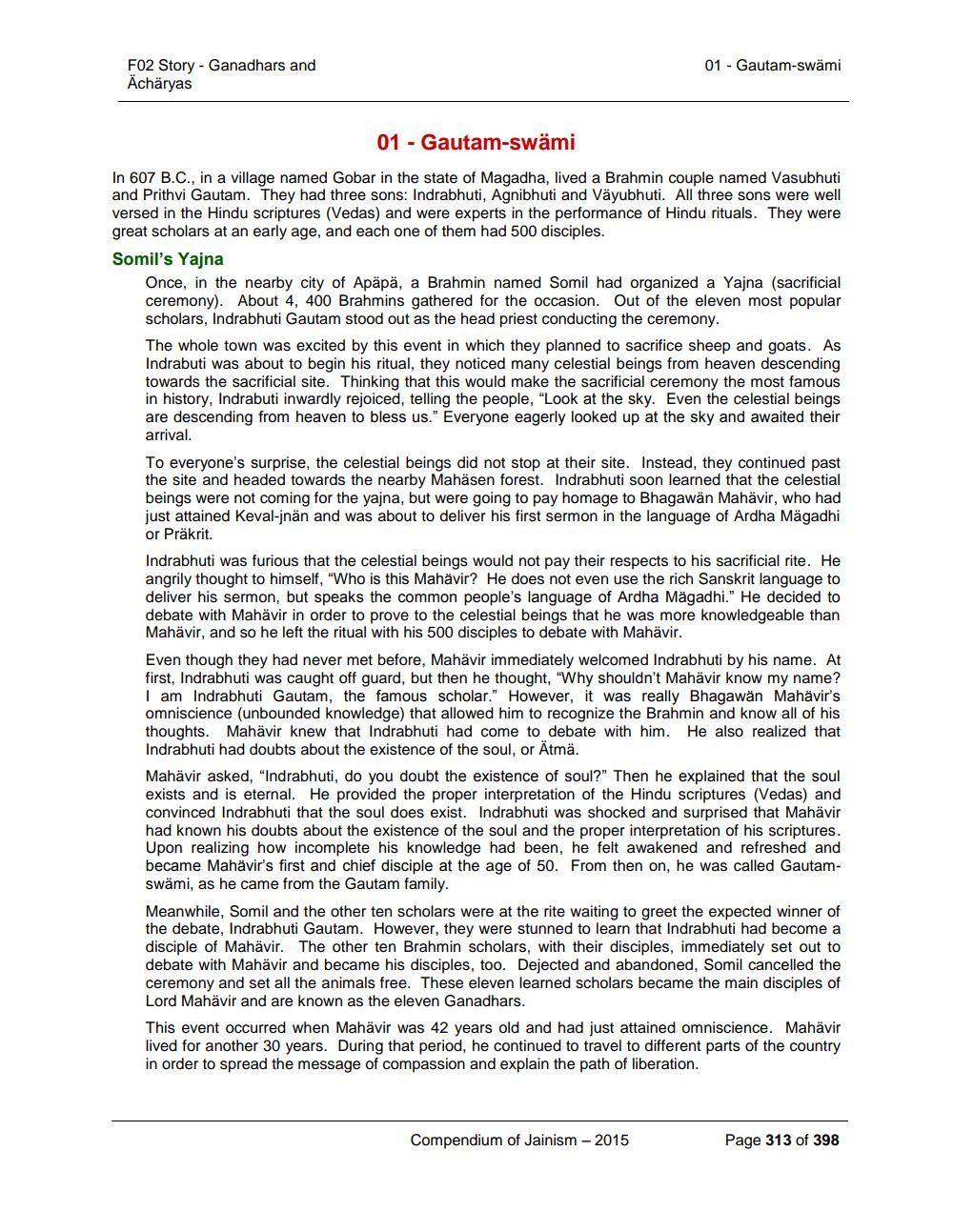________________
01 - Gautam-swami
F02 Story - Ganadhars and Ächäryas
01 - Gautam-swämi
In 607 B.C., in a village named Gobar in the state of Magadha, lived a Brahmin couple named Vasubhuti and Prithvi Gautam. They had three sons: Indrabhuti, Agnibhuti and Väyubhuti. All three sons were well versed in the Hindu scriptures (Vedas) and were experts in the performance of Hindu rituals. They were great scholars at an early age, and each one of them had 500 disciples. Somil's Yajna
Once, in the nearby city of Apäpä, a Brahmin named Somil had organized a Yajna (sacrificial ceremony). About 4, 400 Brahmins gathered for the occasion. Out of the eleven most popular scholars, Indrabhuti Gautam stood out as the head priest conducting the ceremony. The whole town was excited by this event in which they planned to sacrifice sheep and goats. As Indrabuti was about to begin his ritual, they noticed many celestial beings from heaven descending towards the sacrificial site. Thinking that this would make the sacrificial ceremony the most famous in history, Indrabuti inwardly rejoiced, telling the people, "Look at the sky. Even the celestial beings are descending from heaven to bless us." Everyone eagerly looked up at the sky and awaited their arrival.
To everyone's surprise, the celestial beings did not stop at their site. Instead, they continued past the site and headed towards the nearby Mahäsen forest. Indrabhuti soon learned that the celestial beings were not coming for the yajna, but were going to pay homage to Bhagawan Mahävir, who had just attained Keval-jnän and was about to deliver his first sermon in the language of Ardha Mägadhi or Präkrit. Indrabhuti was furious that the celestial beings would not pay their respects to his sacrificial rite. He angrily thought to himself, "Who is this Mahävir? He does not even use the rich Sanskrit language to deliver his sermon, but speaks the common people's language of Ardha Mägadhi." He decided to debate with Mahavir in order to prove to the celestial beings that he was more knowledgeable than Mahävir, and so he left the ritual with his 500 disciples to debate with Mahävir. Even though they had never met before, Mahävir immediately welcomed Indrabhuti by his name. At first, Indrabhuti was caught off guard, but then he thought, "Why shouldn't Mahävir know my name? I am Indrabhuti Gautam, the famous scholar." However, it was really Bhagawan Mahävir's omniscience (unbounded knowledge) that allowed him to recognize the Brahmin and know all of his thoughts. Mahävir knew that Indrabhuti had come to debate with him. He also realized that Indrabhuti had doubts about the existence of the soul, or Atmä. Mahävir asked, "Indrabhuti, do you doubt the existence of soul?" Then he explained that the soul exists and is eternal. He provided the proper interpretation of the Hindu scriptures (Vedas) and convinced Indrabhuti that the soul does exist. Indrabhuti was shocked and surprised that Mahävir had known his doubts about the existence of the soul and the proper interpretation of his scriptures. Upon realizing how incomplete his knowledge had been, he felt awakened and refreshed and became Mahavir's first and chief disciple at the age of 50. From then on, he was called Gautamswämi, as he came from the Gautam family. Meanwhile, Somil and the other ten scholars were at the rite waiting to greet the expected winner of the debate, Indrabhuti Gautam. However, they were stunned to learn that Indrabhuti had become a disciple of Mahävir. The other ten Brahmin scholars, with their disciples, immediately set out to debate with Mahävir and became his disciples, too. Dejected and abandoned, Somil cancelled the ceremony and set all the animals free. These eleven learned scholars became the main disciples of Lord Mahävir and are known as the eleven Ganadhars. This event occurred when Mahävir was 42 years old and had just attained omniscience. Mahävir lived for another 30 years. During that period, he continued to travel to different parts of the country in order to spread the message of compassion and explain the path of liberation.
Compendium of Jainism - 2015
Page 313 of 398




